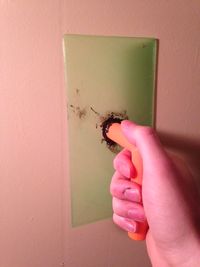Cryofixated (talk | contribs) (Created page with "{{777}} ==Grout Trowel == Project developed by Ethan Marshall {{Statusboxtop}} {{status-design}} {{status-prototype}} {{Status-Model}} {{status-verified|U...") |
Cryofixated (talk | contribs) No edit summary |
||
| Line 1: | Line 1: | ||
{{777}} | {{777}} | ||
==Grout Trowel == | ==Grout Trowel == | ||
Project developed by | Project developed by Eric Hecht | ||
{{Statusboxtop}} | {{Statusboxtop}} | ||
{{status-design}} | {{status-design}} | ||
{{status-prototype}} | {{status-prototype}} | ||
{{Status-Model}} | {{Status-Model}} | ||
{{boxbottom}} | {{boxbottom}} | ||
==Abstract== | ==Abstract== | ||
When spreading grout for tiling in areas like the kitchen or bathroom a normal tool may prove to be to large and unwieldy. My landlord asked for a cheap 3D printable tool that could fufill three tasks. The first main taks and what this tool is made for is spreading grout for tiling. However there are two other functions that you can use this for: smoothing concrete, and spackling. Those secondary applications won't work as well as a dedicated tool but this tool can still perform them. And as a bonus function you can table sandpaper to the bottom of this and use it as a sanding aparatues if you are lacking a powersander! | |||
[[Image:ConcreteTrowel_1.jpg|200px|middle]] | [[Image:ConcreteTrowel_1.jpg|200px|middle]] | ||
| Line 18: | Line 17: | ||
STL | STL | ||
*[[file: | *[[file:bricktrowel.stl|Masonry Handle]] | ||
Purchased materials | Purchased materials | ||
* | *1kg of White PLA Filament | ||
== Tools needed for fabrication of the OSAT== | == Tools needed for fabrication of the OSAT== | ||
# [[Athena Build Overview| MOST Delta RepRap]] | # [[Athena Build Overview| MOST Delta RepRap]] | ||
| Line 31: | Line 30: | ||
== Technical Specifications and Assembly Instructions== | == Technical Specifications and Assembly Instructions== | ||
-Overall tool base dimensions Length and Width are | -Overall tool base dimensions Length and Width are 6in by 3in. | ||
- The | - The Grout Trowel | ||
*Layer Height: 0. | *Layer Height: 0.15 mm | ||
*Top/Bottom layer thickness: 0.75 mm | *Top/Bottom layer thickness: 0.75 mm | ||
*Shell Thickness: | *Shell Thickness: 2 | ||
*Fill Density: 100% | *Fill Density: 100% | ||
*Printer Speed: 30 mm/s | *Printer Speed: 30 mm/s | ||
*Travel Speed: 50 mm/s | *Travel Speed: 50 mm/s | ||
- Print | - Print time: 4 hours and 36 min with a raft, or 3 hours 29 min without a raft. | ||
-Assembly | -Assembly | ||
* | *N/A | ||
=== Common Problems and Solutions=== | === Common Problems and Solutions=== | ||
* | *If printed without a raft the corners may warp upwards due to heat and not enough proper adhesion to the base. Either add a raft of go more carefully over the surface area with glue. | ||
== Cost savings== | == Cost savings== | ||
* | *65 g of PLA filament were used which was a total cost of $1.2 at $20.12 for 1 kg of PLA filament | ||
* | *Grout Trowel can range in price from $3.00 to $50 | ||
*The cost savings would be $1.55 to $48.55 | *The cost savings would be $1.55 to $48.55 | ||
*The cost savings in percent would be 51% to 97.1% | *The cost savings in percent would be 51% to 97.1% | ||
Revision as of 15:17, 8 December 2015
Grout Trowel
Project developed by Eric Hecht
Template:Statusboxtop Template:Status-design Template:Status-prototype Template:Status-Model Template:Boxbottom
Abstract
When spreading grout for tiling in areas like the kitchen or bathroom a normal tool may prove to be to large and unwieldy. My landlord asked for a cheap 3D printable tool that could fufill three tasks. The first main taks and what this tool is made for is spreading grout for tiling. However there are two other functions that you can use this for: smoothing concrete, and spackling. Those secondary applications won't work as well as a dedicated tool but this tool can still perform them. And as a bonus function you can table sandpaper to the bottom of this and use it as a sanding aparatues if you are lacking a powersander!
Bill of Materials
CAD files of parts FreeCAD files found here
STL
Purchased materials
- 1kg of White PLA Filament
Tools needed for fabrication of the OSAT
Skills and Knowledge Necessary to Make the OSAT
- N/A
Technical Specifications and Assembly Instructions
-Overall tool base dimensions Length and Width are 6in by 3in.
- The Grout Trowel
- Layer Height: 0.15 mm
- Top/Bottom layer thickness: 0.75 mm
- Shell Thickness: 2
- Fill Density: 100%
- Printer Speed: 30 mm/s
- Travel Speed: 50 mm/s
- Print time: 4 hours and 36 min with a raft, or 3 hours 29 min without a raft.
-Assembly
- N/A
Common Problems and Solutions
- If printed without a raft the corners may warp upwards due to heat and not enough proper adhesion to the base. Either add a raft of go more carefully over the surface area with glue.
Cost savings
- 65 g of PLA filament were used which was a total cost of $1.2 at $20.12 for 1 kg of PLA filament
- Grout Trowel can range in price from $3.00 to $50
- The cost savings would be $1.55 to $48.55
- The cost savings in percent would be 51% to 97.1%
Gallery













